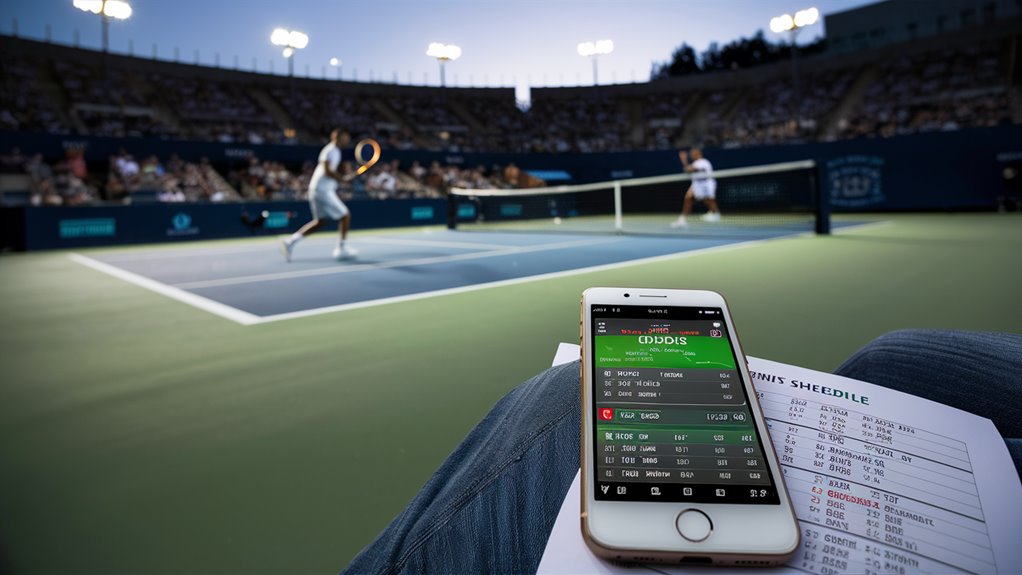
The Best Strategies for Betting on Tennis
Best Strategies for Tennis Betting: An Expert Guide
The Three Core Elements for Successful Betting
There are three pillars of success in betting on Tennis: a full analysis of the playing surface, head-to-head statistics with great detail, and disciplined bankroll management. Comprehend these elements and you’ll get a substantial edge, which is essential in a tough market like tennis betting.
Understand where players most excel. Different surfaces can cause players’ win rates to fluctuate. Clay, for instance, gets a winning percentage of some 30% less than that on hard steps. You should check figures with a master-500, which will either confirm your hunch or cause other headaches if it implies commensurate losses.
Wherever possible, procure reliable performance data from a minimum of 50 matches played on each of the court surfaces.
Generate Real-time Edge Statistics
Through match statistics in real-time, liked by bettors but often not provided by brokers:
- Serve percentage
- Conversion of break points
- Return games won
Professional Management of Banking Matters
Strictly manage your bankroll in order for long-term success:
- Each bet can only be worth 1-3% of your total bankroll.
- Utilize the optimal bet-size according to Kelly Criterion.
- Track separately the return on investment for different sorts of bets.
- Record how you do on each surface.
- Continuous maintenance of written betting logs always proves beneficial to the bottom line.
These advanced strategies enable you to identify betting situations that are truly attractive through systematic analysis and trustworthy execution, maximizing the potential return while keeping risk under control.
Tennis Betting Markets Explained
Main Tennis Betting Markets
On the tennis betting landscape, you can find a number of important markets. These give you all kinds of choices in terms of betting. For putting together effective betting strategies, it is important that you understand these markets.
Match Winner Market
Match winner betting is the most basic market in the world of tennis wagering. With this easy one-facet market, you just pick whoever finally wins the match, not at all with regard to what that person’s score is or how long he had to play for.
Set Betting Markets
By choosing the exact score of the match, set betting allows for a different kind of betting. For best-of-three matches, there are only 2 possible results that will give the scoreline 2-0 or 2-1; however, in best-of-five matches, there are more combinations still.
Game Handicap Markets
Game handicap betting works exactly like the point spread in other sports. This market permits you to gamble on whether a player wins by how many games, offering more complex and more gambling opportunities than simple winner betting on tennis matches.
Over/Under Totals Markets
The over/under on totals points market is focused strictly on the total number of games played in a match. When looking at a line for 22.5 games, important things a bettor must consider include:
- The surface characteristics upon which play takes place.
- How do the players themselves play.
- Data for historical match duration.
- Statistics for head-to-head.
Market Analysis Strategies
Different markets need different analysis strategies:
- Match winner analysis: Focus on how competitors’ records stand.
- Set betting estimation: Consider the player’s endurance and the history of which sets they’ve won or lost during whole matches.
- Handicap one thinking: Check out the manner in which serves are performed for statistical analysis and break probability.
- Totals calculation: Look at average playing type Glassgrain Slots comparison factors at match time and duration generally played between such players before it is set thinking on totals anymore.
Head-to-Head Stats Count
The Importance of Head-to-Head Stats in Tennis Betting
Know Historical Matchup Data
Head-to-head statistics may be considered the bedrock of intelligent tennis betting strategies. The historical match-ups between particular players often yield insights that are key to future events. The present rankings or recent trends frequently did not manage to apply to player-match dynamics. In fact, some players have continued to have a complete one-man show against one another.
Key Statistical Indicators for Analysis
Specific head-to-head metrics require careful estimation. A comparatively simple calculation will determine if the difference between win-loss ratios on various surfaces and playing duration parameters for that particular match-up is significant.
Temporal Relevance and Current Significance
In head-to-head encounters during a two-year period, recent matches have predictive power. Yet, comprehensive historical data remains relevant, particularly in older rivalries. For betting purposes, analyzing the surface type of matches, tournament level, and round comparability is necessary for relevant context, although it should not be seen as an absolute determinant.
Surface-Specific Performance Indicators
- Rates of clay-court victories
- Patterns of hard-court success
- Head-to-head statistics for grass courts
- Indoor/outdoor performance ratios

Tournament Context Factors
- Grand Slam head-to-head data
- ATP Tour level performance records
- Win-loss percentages
- Prize money effect
Court Surface Analysis
Court Surface Analysis in Tennis: Its Effects on Betting Results
Development of Court Surface Conditions
The characteristics of court surfaces are a key factor determining success in tennis: Each of the three playing surfaces – clay, grass, and hard court – possesses distinct characteristics which heavily influence competition results.
- Clay courts lead to slower ball speeds as well as higher bounces, so they naturally favor baseliners emphasizing topspin.
- Grass court rewards serve-and-volley play to a far greater degree due to a lower bounce and faster ball speed.
Surface-Specific Performance Indicators
Key Statistical Indicators:
- First-serve score
- Service point win
- Operating rate of break points
- Elite player surface differential
Statistical evidence supports the need for specialization by surface. This conclusion is strongly supported by the experience of Rafael Nadal, who has a 91% win record on clay and only 78% on hard courts. These striking differences indicate the importance of being specifically attentive to surfaces when analyzing a bet’s prospects. Arc & Ember Bets
A Database for Data-Driven Betting Analysis
Developing an exhaustive surface-specific database involving no fewer than 50 matches played on each surface by each player gives you the chance to figure out:
- High-value betting opportunities
- Individual player surface advantages
- Performance trend analysis
The systematic approach to analyzing court surfaces gives bettors a wealth of solid data to help inform their decisions and guide them strategically through betting.
Managing Your Tennis Money
Tennis Investment Management Strategy
Key Investment Principles
Professional tennis betting means using an established method similar to a mutual fund or insurance company portfolio to maximize the effect of risk choice and cash protection as well as making sure you can get out safely with all your profits.
- Bet between 1% (level of risk) to 3% of the total amount as a stake.
- Working this way will prevent catastrophic losses when the long-forgotten lean cycle catches up with you sooner rather than later and ensure steady, long-term survival.
Advanced Track Methods
Upholding an accurate guide to business transactions provides a solid foundation for tennis wagering success. 슬롯사이트 추천
Things to remember:
- You’ll need a detailed spreadsheet covering bet size, odds, outcome, and return on each wager for future reference.
- Examining the data it generates reveals betting patterns and helps make strategic adjustments.
Optimal bet size is calculated using the Kelly Criterion, which takes into account perceived statistical edges.
Tournament-Based Management
During big tournaments and Grand Slams, you should think in terms of:
- For normal plays: stakes at 1%.
- Choosing those high-confidence selections: stakes at 2%.
- Stakes at 3% for the most important events with major advantages.
This size allocation strategy leads to a bankroll more comfortably preserved and well-used throughout play.

